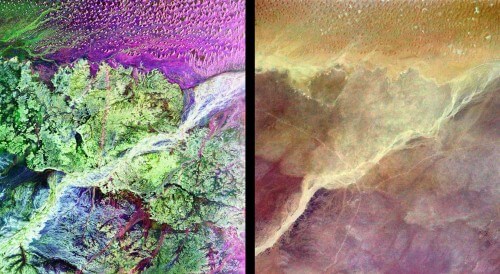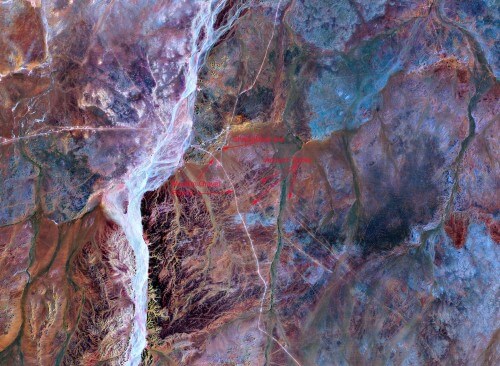Climate changes, some small and some large - are at least partially responsible for the rise and fall of many ancient civilizations. Jason Orr of Harvard says that in all the sites he excavated he found no evidence of any attempt by the last inhabitants to adapt to climate change, and we should learn from their experience and not repeat their mistakes

The search for the lost city of Uber began with a phone call at NASA's Jet Propulsion Laboratory in 1982.
Documentary filmmaker Nicholas Clapp heard stories of a lost settlement in the desert of the Arabian Peninsula that was once rich and prosperous. At some point, a few hundred years ago, Uber disappeared into the sands and Clapp wondered if a NASA spacecraft could be used to search for the lost city.
"When he [Nicolas Clapp] called, it was clear that he was not one of the crazy people who occasionally call us," says Dr. Ron Blum, director of the "Earth Earth Sciences" program and a natural disaster expert at JPL. "Nick stood out in that he did his homework before contacting us."
And so the search began.
With the help of Clapp's historical research, Blum and his team used the space shuttle Challenger (which this week marked the 28th anniversary of its crash) to take pictures in the desert. These images allowed them to locate ancient roads in the desert, some of which were buried under sand dunes, but all of which finally met at one central point: in southern Oman. In archeological excavations conducted by the team in this area, a site was found that matched some of the theories of the mythological Uber. The researchers also discovered that the site contained an important water source and a meeting point where camel caravans gathered to lead to the beaver. In the 30 years that have passed since the use of the space shuttle "Challenger", researchers have recruited the best of NASA's satellites for the purpose of studying the Earth at different wavelengths.
Climate changes, some small and some large, are at least partially responsible for the rise and fall of many ancient civilizations.
The city of Uber, which was surrounded by tall towers that sunk into the sand, is just one of a long list of historical sites that have been revealed thanks to satellite images. The field of "remote sensing" makes it possible to take pictures from a great height and thus reveal evidence of the location of lost companies, which cannot be seen from the ground.
[Section of the empty southern quarter of the Arabian Peninsula in the state of Oman. On the left: a radar image of the surroundings of the lost city of Uber. Right: enhanced optical images, taken by astronauts of one of the space shuttles. Photo: NASA/JPL]
When scientists have excavated these sites, they are uncovering evidence that climate changes, both small and large, are at least partially responsible for the rise and fall of many ancient civilizations. Although Ubar is currently located in one of the driest places on earth, in ancient times the area was steeped in water above and below the ground. Uber disappeared when the water levels dropped so low that the sand collapsed and buried the city.
Like Uber, 4200 years ago an Egyptian kingdom collapsed during a period of drought. In forms also related to the fall of the Maya around 900 AD as well as the destruction of the Cambodian city of Angkor around 1400 AD.
"It is not surprising that climate change has destroyed so many populations throughout history," says Bloom. "After all, the formation of complex cultures became possible 11,500 years ago, when the weather stabilized so that it could be relied upon and predicted to a reasonable degree. A stable climate ensures that the crops will grow year after year, and thus a reliable source of food freed the people to settle in the place and develop a culture."
Since then, many civilizations flourished and rose to greatness but eventually disappeared and turned into ruins. When scientists try to map where people lived a long time ago, they use the most modern technologies. Spacecraft can offer an unprecedented view of Earth from above.
There are many ways to locate lost settlements using satellite images. In the search for the lost city of Uber, Blum and his team used radar and computers to enhance the images that were taken at different wavelengths - visible light and infrared. These methods allowed the researchers to observe up to a depth of 5 meters below the dry sands. When they analyzed the size and ratio of the dust particles, rocks and sand grains, they could see the limits of the ancient ways.

In present-day Iraq and Syria, archaeologist Dr. Jason Ur and his colleagues are using NASA satellite images to identify thousands of potential sites of Mesopotamian cities by locating lighter, drier soil patterns. These points indicate a place where buildings made of mud bricks collapsed.
Change or disappear
In the case of the disappearance of the Mayan culture and other lost cities in Central and South America, the jungles quickly grow on top of buildings and other formations, and this is how the scientists look for differences in the vegetation patterns in the satellite images. Developed areas are dominated by plants that have taken over the available niche, and these are different from undeveloped areas where the vegetation grows wild. Viewing the vegetation pattern changes from above helps archaeologists focus on areas where it is worth digging.
"The Amazon Basin is larger than the entire United States," says William Woods, a geographer and archaeologist at the University of Kansas in Lawrence. He also notes that "the only way to discover these new things is through remote sensing and verification on the ground."
As archaeologists continued to excavate more and more sites of collapsed civilizations, they discovered evidence that in many cases climate change was at least partially responsible for the disappearance of the civilizations. This connection allows us to discuss opportunities to protect the future of our culture by learning from the mistakes of our ancestors. To this Dr. Jason Orr adds: "When we dug up the remains of ancient civilizations, we rarely found evidence that the people of the time made any attempts to adapt to climate change. I see this inflexibility as the real cause of the collapse of these cultures."
Dr. Or concludes by saying that "today we have at our disposal an unprecedented ability to learn about the environment, to spread the information and to teach future generations. We are required to improve the latest developments in communication technology to deal with a changing climate".
To the article on the NASA website
More of the topic in Hayadan:

3 תגובות
Like in the movie Hulit, the worms swallow the sand
The book "Collapse" by Professor Jared Diamond, and his previous Pulitzer Prize winning book "Guns, Germs and Steel" are the first in the popular wave of books on the topic of the collapse of civilizations. The collapse book is an extension of the topics you listed in your article that you took from the NASA website. Exactly the same topics and cultures that you covered are some of those that appear in the book. Out of the whole pile of popular books on the subject (a summary of human history, etc.), these two books are recommended.